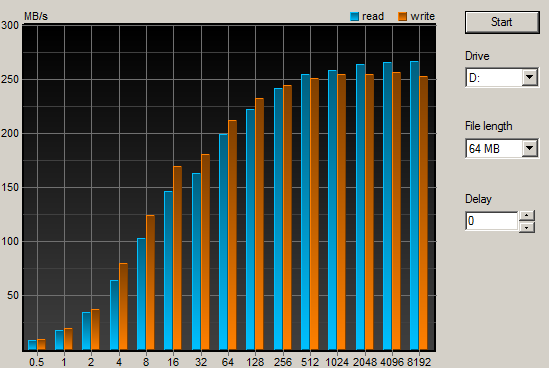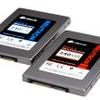Your SSD and choosing the right SATA controller
SATA Controllers
Before we start off with all the benchmarks I wanted to quickly show you how important it is to connect your SSD to the right controller on your motherboard. If you purchase a SATA3 SSD you want to connect it to a SATA3 port. However, motherboards use different controllers per motherboard, basically you have the Intel/AMD Chipset controllers, or 3rd party controllers added onto the motherboard like Marvell and ASMedia.
The 3rd party controllers are not bad at all, but never seem to reach the performance the native chipset controller can achieve. In this chapter we'll demonstrate that, have a peek -- all results on this page have been done with a Corsair Force GS SSD (240GB model).
So, the SSD used on this page is merely for reference.

INTEL SATA2 - Above we have connected the SATA3 SSD to a SATA2 port (Intel) of the motherboard. Bandwidth is your main issue and as you can see, you'll never pass ~270 MB/sec. Use these ports for your optical drives and HDDs.

Asmedia SATA3 - In the above example we connected the SSD to a proper SATA3 port, this port however is managed by a 3rd party controller from ASMedia. Albeit we have a good performance increase over the SATA2 port, we still run into a bottleneck as this controller does not have enough breathing space for the SATA3 SSD. Granted -- 375Mb/sec is obviously excellent performance -- but high-end SSDs simply can go faster.

INTEL SATA3 - Once we connect the SSD to the native Intel SATA3 port, that's where things increase indefinitely as the SSD is freed up from any bottlenecks and bandwidth issues. We have now passed 500 MB/sec.
So our advice is simple -- should you be in the market for a SATA 3 SSD then we absolutely prefer the performance of the Intel Series 6 or 7 (H67/P67/Z68/X79/H77/Z77) integrated SATA 6G controller over anything else available on the market.
The new Marvell and Asmedia controllers also offer good performance, albeit still 20%~25% slower than Intel's controllers.
When you install an SSD, make sure you run your drive in AHCI mode, it does make a significant difference in performance.
But what is SATA 3 (6Gbps)?
SATA3, the latest revision of your SATA storage unit connectors, will increase the bandwidth on the SATA controller from 3 GBit/sec to 6 GBit/sec. For your run of the mill HDD that is not really very important. But with the tremendous rise of fast SSD drives this really is a large plus.
For SATA2 typically we get 3000 Mbit/s : 8 = 375 MB/sec bandwidth minus overhead, tolerances error-correction and random occurrences.
SATA3 doubles the bandwidth up, as such we get 6000 Mbit/sec : 8 = 750 MB/sec (again deduct overhead, tolerances, error-correction and random occurrences) of available bandwidth for your storage devices. As you can understand, with SSDs getting faster and faster that's just a much warmed and welcomed increase of bandwidth.
Alright, let's dive into the performance benchmarks.

